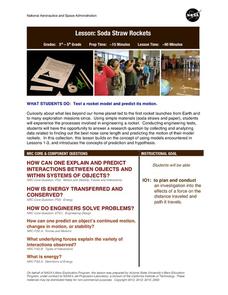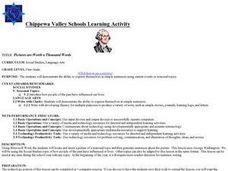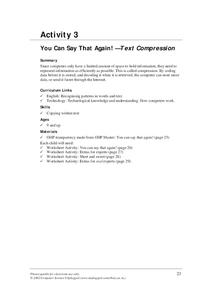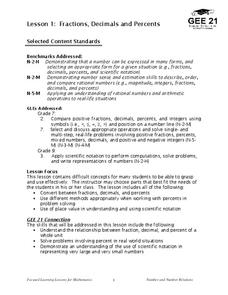Center for Civic Education
The Power of Nonviolence: Rosa Parks: A Quest for Equal Protection Under the Law
Teach young historians about the historical legacy of Rosa Parks with a multi-faceted lesson plan. Pupils follow stations and use journals to explore prominent events, analyze primary resource documents, and engage in interesting...
NASA
Soda Straw Rockets
Three, two, one, blast off to a better understanding of force and motion with this exciting science instructional activity! Beginning with a discussion about rockets and gravity, young scientists go on to complete a series of worksheets...
University of Georgia
Energy Content of Foods
Why do athletes load up on carbohydrates the evening before a competition? The lesson helps answer this question as it relates the type of food to the amount of energy it contains. After a discussion, scholars perform an experiment to...
Santa Monica College
Introducing Measurements in the Laboratory
We use basic units of measurement to break down things and communicate clearly. The first lesson in an 11-part series teaches the proper way to measure various items. It starts simply with measuring the dimensions and areas of geometric...
University of Georgia
What's So Special about Bottled Drinking Water?
Is artesian water designed to be better, or is it just from wells similar to those in the city of Artesium? This experiment looks at many different types of bottled waters, including artesian. Using a soap mixture, scholars test to see...
Habits of Mind
Haileybury Habits of Mind Learning Resource Book
Imagine a learning community committed to using Costa and Kallick's Habits of Mind as the basis of curriculum design. The resource book is packed with lessons that are designed for and identify the standards and habits of mind targeted...
Virginia Department of Education
Charles’ Law
Searching for a relatively interesting way to demonstrate Charles' Law? Here is a instructional activity in which pupils heat air inside a flask and then cool the flask to quickly cool the air. They make observations about what occurs...
LABScI
Harmonic Motion: Pendulum Lab
Several times throughout history, groups of soldiers marching in rhythm across a suspension bridge have caused it to collapse. Scholars experiment with pendulums, resonance, and force to determine why this would happen. First, pupils...
Curated OER
What is a file?
Young scholars demonstrate procedures for opening and closing files. They write a story using Microsoft Word and practice opening, closing and saving the file.
Curated OER
Building Arrays Using Excel Spreadsheets
Students create arrays using Microsoft Excel. In this technology-based math instructional activity, students expand their knowledge of multiplication by creating arrays on the computer using a spreadsheet program such as Microsoft Excel.
Curated OER
Pictures Are Worth A Thousand Words
First graders write simple sentences based on historical figures they find in pictures. In this simple sentences lesson plan, 1st graders search for pictures in Microsoft Word and write simple sentences about them. These pictures and...
Curated OER
Résumé Rights
Students build a practical resume using Microsoft Word R??sum?? Wizard. Hints useful for avoiding "r??sum?? wrongs" helps them develop the right r??sum?? for their job hunting needs.
Curated OER
A Picture Is Worth at Least One Word
Students explore clip art pictures to create a rebus. In this clip art lesson, students define what a rebus is and then create their original rebuses. Students use clip art from the computer to design their rebuses.
Curated OER
Integrated Project
Students participate in a project that integrates Microsoft Word, Excel and PowerPoint. In groups, they write a proposal for their project and complete the necessary steps to create and design it. To end the lesson, they are graded...
Curated OER
History Trifold in Publisher
Students create a timeline of events happening around the world. In this timeline lesson plan, students use Microsoft Publisher to create a timeline of events happening around the world as they live their lives presently.
Curated OER
Background of Diseases-- Germs or Genes?
Students explore the background of common diseases. In this personal health lesson, students research causative agents of communicable and non-communicable diseases. Students use their research findings to create data tables in Microsoft...
Computer Science Unplugged
You Can Say That Again! – Text Compression
Compression, the process computers use to store information, is the focus of a resource that presents two different stories that describe the concept of compression by eliminating repeated letters and replacing them with a pointer. The...
University of Chicago
Addressing Stereotypes
How is a stereotype defined, and what are some mechanisms we can use to combat negative stereotyping? Your young historians will discuss how and why stereotyping occurs, as well as consider the roots of modern conceptions of the Middle...
Louisiana Department of Education
Fractions, Decimals, and Percents
Fractions, decimals, and percents all say the same thing! Show your classes how to convert between the three forms using visual and numeric representations. Then lead them to an understanding of scientific notation.
Curated OER
The Adventures of Tom Sawyer: Anticipation Guide
Start off your study of The Adventures of Tom Sawyer with a lesson plan spent exploring some of the concepts that will be present in the novel. This anticipation guide focuses on honesty and lying. After learners decided if they agree or...
Curated OER
Pride and Prejudice: Biopoem
Describe yourself or a character from Jane Austen's Pride and Prejudice with a biopoem activity. Using the provided format, kids write their own characteristics or the character traits from the novel to create a poetic portrait.
Curated OER
Descriptive writing
Fourth graders practice writing with description. In this descriptive lesson, 4th graders see the results of a task when the directions are not clear. They come up with descriptive words and write their own instructions.
Curated OER
Interior Design- Textiles
Students investigate natural and synthetic fibers. In this textiles lesson plan, students pass around samples of carpet, drapes and clothing and decide what they are made of. Students use KWL charts to organize information from reading...
Curated OER
The Lost Flyer
Fourth graders, using Microsoft Word, create a notice of a lost pet flyer. They use a border, exaggerated fonts, colors and clip art.

























